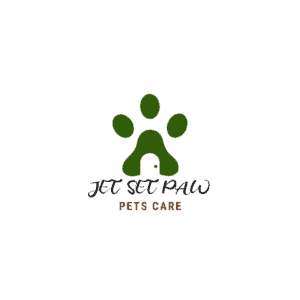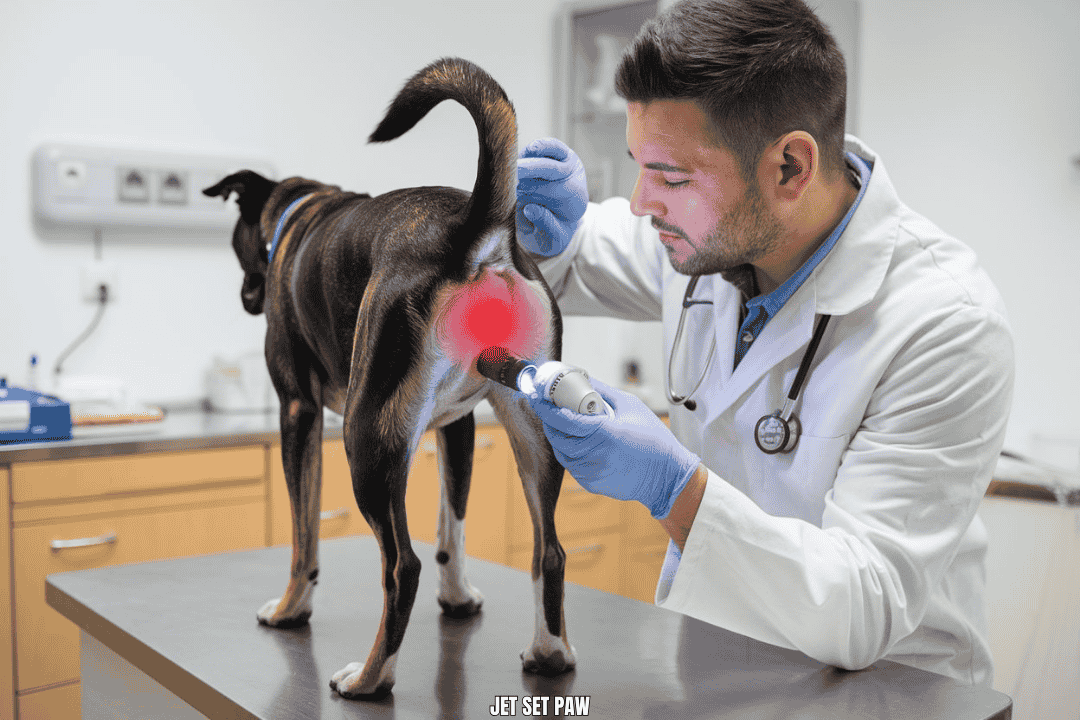When our furry friends are uncomfortable, it’s our job to help them feel better. One problem that dogs sometimes face is an irritated anus.
Various issues, like allergies, infections, or digestive problems, can cause this. It’s not a fun topic to discuss, but knowing how to help your dog if they’re dealing with this problem is essential.
Addressing this issue is crucial for several reasons. First, it can be uncomfortable for your dog, causing them to scoot across the floor or constantly lick the area. This behavior can make the irritation worse and even lead to infections.
Second, an irritated anus might be a sign of a more serious health problem that needs a vet’s attention. By learning how to soothe your dog’s irritated anus, you can help them feel better and catch any potential health issues early on.
This knowledge will make you a better pet owner and ensure your dog stays happy and healthy.
Understanding the Problem
To help your dog, it’s essential to understand what might be causing their discomfort. There are several common reasons why dogs get an irritated anus.
These can include allergies to food or environmental factors, parasites like worms, infections, or problems with their anal glands.
Sometimes, it might be caused by diarrhea or constipation, which can irritate the area. In some cases, injuries or even tumors could be the culprit.
Knowing what to look for can help you spot the problem early. Keep an eye out for these signs and symptoms:
- Scooting: If your dog drags their bottom across the floor, it’s often a sign of irritation.
- Excessive licking: Your dog might spend much time licking or biting at their rear end.
- Redness or swelling: The area around their anus might look inflamed or puffy.
- Unusual odor: You might notice a bad smell coming from your dog’s rear end.
- Changes in bathroom habits: Your dog might have trouble pooping or seem to be in pain when they do.
- Visible discharge: You might see pus or blood around their anus.
If you notice any of these symptoms, check your dog’s rear end (if they’ll let you) and consider the next steps to help them feel better. Remember, it’s always best to consult your veterinarian if symptoms persist or seem severe.
At-Home Remedies
There are several things you can do at home to help soothe your dog’s irritated anus. These remedies can provide relief and comfort for your furry friend while you determine if a vet visit is necessary.
First, gently clean the area around your dog’s anus. Use warm water and a soft cloth or unscented baby wipes. Be careful not to rub too hard, which can cause more irritation. Pat the area dry with a clean towel.
This cleaning helps remove any dirt, debris, or discharge that might be causing or worsening the irritation.
Next, try applying a cool compress to the affected area. Use a clean washcloth soaked in cool water or wrap an ice pack in a thin towel.
Hold this against your dog’s irritated anus for about 5-10 minutes at a time, a few times a day. The coolness can help reduce swelling and provide some relief from the discomfort.
Lastly, you can use soothing ointments to help your dog feel better. Look for pet-safe products that contain ingredients like aloe vera or witch hazel, which can help reduce inflammation.
You can also ask your vet about using a small amount of hydrocortisone cream, which can help with itching. Always ensure any product you use is safe for dogs, and apply it gently to avoid causing more irritation.
Remember, while these at-home remedies can help, they’re not a substitute for professional veterinary care if the problem persists or worsens.
Dietary Changes
Sometimes, making changes to your dog’s diet can help with anal irritation. These changes can improve your dog’s digestive health and potentially reduce the chances of future problems.
Increasing your dog’s fiber intake can be helpful. Fiber helps keep your dog’s poop soft and easy to pass, which can reduce strain and irritation.
You can add fiber to your dog’s diet in several ways. Mix small canned pumpkins (not pumpkin pie filling) into their regular food. Pumpkin is high in fiber, and many dogs enjoy its taste.
You can also add some cooked, plain vegetables like green beans or sweet potatoes to their meals. Ask your vet for advice if you’re unsure how much to add.
Making sure your dog drinks enough water is also essential. Proper hydration helps keep your dog’s poop soft and prevents constipation, which can irritate their anus.
Always have fresh, clean water available for your dog. If your dog doesn’t drink much water, add some low-sodium chicken broth to their water to make it more appealing. You can also feed wet food with more moisture than dry kibble.
Remember, any changes to your dog’s diet should be made gradually to avoid upset stomachs. If you’re unsure about making dietary changes, it’s always a good idea to consult your veterinarian first. They can advise you based on your dog’s needs and health conditions.
Lifestyle Adjustments
Making some changes to your dog’s daily routine can help prevent and reduce anal irritation. Regular exercise is an integral part of keeping your dog healthy.
Taking your dog for daily walks or playing fetch can help stimulate bowel movements and reduce constipation, which can irritate. Exercise also helps maintain a healthy weight and reduces stress, which suits your dog’s overall health.
Another critical step is keeping your dog’s living area clean. Wash your dog’s bedding weekly in hot water and vacuum or sweep areas where your dog spends a lot of time.
Don’t forget to clean and disinfect food and water bowls regularly. If your dog spends time outside, pick up waste promptly to prevent parasite reinfection. Keeping the yard free from standing water can also help reduce bacteria.
Grooming is also part of maintaining a clean environment for your dog. Regular baths using dog-specific shampoo can help keep your dog clean.
You might also need to trim the hair around your dog’s bottom to prevent matting and trapped feces. Some dogs might need their bottoms wiped after going to the bathroom.
By making these lifestyle adjustments, you can help reduce the chances of your dog developing anal irritation and improve their overall health. Remember, it’s important to be consistent with these changes for the best results.
When to See a Vet
While home care can help with many cases of anal irritation in dogs, there are times when you should take your pet to see a veterinarian. It’s important to know when professional help is needed to ensure your dog’s health and comfort.
If your dog’s symptoms don’t improve after a few days of home treatment, it’s time to see a vet. Persistent redness, swelling, or discomfort around the anus could mean there’s a more serious problem that needs medical attention.
Also, if your dog keeps licking or biting at their rear end even after you’ve tried to help, this could be a sign that they’re still uncomfortable.
You should also watch for signs of infection or more serious issues. These can include bleeding from the anus, a foul smell coming from your dog’s rear end, or pus or discharge around the anus.
If your dog seems to be in a lot of pain, has a fever, loses their appetite, or seems very tired, these could be signs of a more serious problem. Vomiting or diarrhea that lasts more than a day or two is also a reason to see the vet.
Remember, it’s always better to be safe than sorry about your pet’s health. If you’re unsure whether your dog needs to see a vet, it’s okay to call and ask. They can help you decide if your dog needs a check-up.
Prevention Tips
Preventing anal irritation in your dog is often easier than treating it. You can take several steps to help keep your dog comfortable and healthy.
Regular grooming is an essential part of prevention. Keeping your dog’s rear end clean and free from matted fur can help prevent irritation.
Brush your dog’s coat regularly, paying special attention to the area around their bottom. If your dog has long fur, you should trim it around their rear end to keep it clean.
After your dog goes to the bathroom, ensure the area is clean. Use a damp cloth or pet wipe to clean the area gently.
Anal gland health is another key factor in preventing irritation. Some dogs need help emptying their anal glands, which are tiny sacs on either side of the anus.
When these glands become full or infected, they can cause discomfort and irritation. You can help keep these glands healthy by ensuring your dog gets enough fiber.
This helps make their stools firmer, which naturally helps empty the glands when your dog poops. Some dogs might need their anal glands expressed manually by a vet or groomer.
By following these prevention tips, you can help reduce the chances of your dog developing anal irritation. Remember, every dog is different, so you should try different approaches to find the best for your pet.
If you’re unsure about how to care for your dog’s anal health, don’t hesitate to ask your vet for advice.
Conclusion
Anal irritation in dogs can be uncomfortable for your pet and concerning for you as an owner. However, with the right knowledge and care, you can often help your dog feel better and prevent future issues.
We’ve covered several important topics in this guide. We talked about how to spot the signs of anal irritation in your dog, like scooting, excessive licking, or visible redness.
We also looked at common causes, including allergies, parasites, and diet issues. We discussed home remedies you can try, such as soothing baths and dietary changes.
We also covered when it’s time to see a vet and how to prevent future problems through grooming and attention to anal gland health.
It’s imperative to address anal irritation in your dog quickly. If left untreated, what starts as a minor irritation can turn into a more serious problem. Your dog might develop infections, or the underlying cause might get worse.
By taking action early, you can help your dog feel better faster and avoid more complicated (and often more expensive) treatments down the road.
Remember, your dog relies on you to notice when something’s wrong and to take care of its health. You can help ensure your furry friend stays comfortable and healthy by staying observant and proactive.
If you’re ever unsure about your dog’s health, don’t hesitate to ask your vet for advice.

